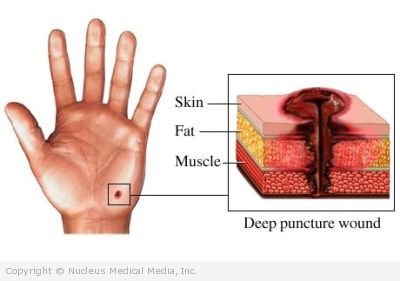Cellulitis – Definition
Cellulitis refers to an infection of the skin and tissue just below the skin. The infection may occur anywhere on the body. It is most common on the lower legs.
Cellulitis – Causes
Cellulitis is often caused by a bacterial infection. It may come from bacteria that normally lives on the skin or bacteria from other sources. The bacterial infection may be caused by:
- A minor injury to the skin (eg, cut, scratch, blister, burn, puncture, or bite) that becomes infected and spreads into the surrounding skin
- Injuries that occur in natural bodies of water that become infected with germs found in the water
- A cut or abrasion that becomes infected by food bacteria while handling fish, poultry, eggs, or meat
- Bacteria that enter the body through surgical wounds or a catheter in a vein
- Bacteria spreading from an upper respiratory or ear infection
Cellulitis – Risk Factors
Factors that may increase the risk of cellulitis include:
- Being bitten by an insect, animal, or human
- Having certain conditions (eg, diabetes, HIV, kidney or liver disease, poor circulation)
- Abusing alcohol or drugs
- Taking steroids on a regular basis
- Undergoing surgery
- Retaining fluids
- Being exposed to certain foods, like raw fish, meat, shellfish, poultry, eggs
Cellulitis – Symptoms
Symptoms may begin within hours or days and can include:
- Skin inflammation that begins in a small area and spreads with:
- Redness
- Pain or tenderness
- Swelling
- Warmth
- A red streak (possibly)
- Swollen lymph nodes
- Fever or chills
- Fatigue
- Confusion
- Cellulitis near the eyes may cause pain with eye movements and should be treated right away.
Cellulitis – Diagnosis
The doctor will ask about your symptoms and medical history. A physical exam will be done. Your doctor will also ask about exposure to natural bodies of water or animals. Your skin will be closely examined. The doctor may mark the border of the cellulitis on your skin. This will help to monitor its progress.
Tests may include:
- Wound culture to test for a bacterial infection
- Blood tests to see if the infection has spread to the bloodstream
In severe cases, the infection can lead to tissue death ( gangrene) or spread to the bone. The doctor may order other tests, such as:
- X-ray
- MRI scan
- Bone scan or CAT scan
Cellulitis – Treatment
The goal is to eliminate the infection and reduce discomfort. Most cases resolve after a week or two of treatment.
Hospital care may be needed if you have:
- Severe cellulitis
- Diabetes or a weakened immune system
- An infection on your face
Treatment includes:
Medication
Antibiotics may be taken by mouth or injected into a muscle or vein. The method will depend on the severity of the infection.
Supportive Care
This may include:
- Elevating the infected area higher than your heart
- Changing the dressings as directed by your doctor
- Protecting your skin from additional injury
- Avoiding scratching or rubbing the area
If you are diagnosed with cellulitis, follow your doctor’s instructions.
Other Treatments
If you have an infected wound, it will need to be cleaned. Dead tissue may be removed. In certain situations, a collection of pus may develop. This is called an abscess, which can be drained.
Cellulitis – Prevention
To reduce your risk of getting cellulitis:
- Keep your skin clean.
- Moisturize dry skin with lotion.
- Avoid injury to the skin:
- Wear protective gear in sports.
- Wear long pants and long-sleeved shirts when hiking.
- Wear sandals when at the beach, rather than going barefoot.
- Be careful around animals. Treat pets with respect to avoid bites.
- Do not swim in natural waters if you have cuts or sores.
- Try not to cut yourself during fishing or other water sports.
- If a small cut, bite, or other injury occurs, carefully care for the wound:
- Clean cuts or scrapes with soap and water.
- Apply antibiotic ointment.
- Cover with a bandage or dressing.
- Do not scratch wounds.
- Call the doctor right away if the area becomes red or inflamed.
- Seek prompt medical care for larger wounds or bites.
- If your legs tend to swell, elevate them several times a day and wear support stockings.
- Get recommended vaccines for children and adults.

